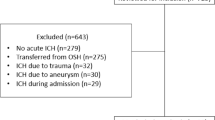Abstract
Introduction
Treatment of elevated blood pressure after acute intracerebral hemorrhage (ICH) is controversial. There is a risk of hematoma expansion with elevated blood pressure, and risk of ischemia with blood pressure control. This study was done to determine the effect of blood pressure control on outcome.
Methods
We retrospectively studied 122 patients with ICH. We collected 24-h blood pressure readings on all patients. The Glasgow Coma Score (GCS) at baseline and at 24 h was used to determine neurological deterioration (GCS decline ≥ 2). Baseline computerized tomography (CT) scans were reviewed for hematoma volume, intraventricular hemorrhage, and location of hemorrhage. Drops in systolic blood pressure and mean arterial pressures over 24 h were divided in quartiles to determine the risk of neurological deterioration among quartiles. A logistic regression model was used to determine the association between variables of interest and neurological deterioration.
Results
Neurological deterioration was observed in 12 patients (10%). Baseline blood pressure and GCS were only two variables significantly different among quartiles of blood pressure drop. Multivariable adjusted analysis for these variables demonstrated significant trend toward reduced neurological deterioration with maximum blood pressure drop (systolic or mean). The risk of neurological deterioration was significantly lower in the quartile of maximum drop of systolic (odds ratio [OR] 0.02, 95% confidence interval [CI] 0.0–0.68) or mean (OR 0.03, 95% CI 0.0–0.98) blood pressure when compared to the quartile with least drop.
Conclusion
This study supports that reduction of blood pressure in patients with acute ICH is safe and suggests that aggressive reduction might reduce the risk of neurological deterioration in first 24 h of admission.


Similar content being viewed by others
References
Qureshi AI, Ezzeddine MA, Nasar A, et al. Prevalence of elevated blood pressure in 563704 adult patients with stroke presenting to the ED in the United States. Am J Emerg Med. 2007;25:32–8.
Powers WJ. Acute hypertension after stroke: the scientific basis for treatment decisions. Neurology. 1993;43:461–7.
Broderick JP, Brott TG, Tomsick T, Barsan W, Spilker J. Ultra-early evaluation of intracerebral hemorrhage. J Neurosurg. 1990;72:195–9.
Chen ST, Chen SD, Hsu CY, Hogan EL. Progression of hypertensive intracerebral hemorrhage. Neurology. 1989;39:1509–14.
Kazui S, Naritomi H, Yamamoto H, Sawada T, Yamaguchi T. Enlargement of spontaneous intracerebral hemorrhage. Incidence and time course. Stroke. 1996;27:1783–7.
Ohwaki K, Yano E, Nagashima H, Hirata M, Nakagomi T, Tamura A. Blood pressure management in acute intracerebral hemorrhage: relationship between elevated blood pressure and hematoma enlargement. Stroke. 2004;35:1364–7.
Maruishi M, Shima T, Okada Y, Nishida M, Yamane K. Involvement of fluctuating high blood pressure in the enlargement of spontaneous intracerebral hematoma. Neurol Med Chir. 2001;41:300–5.
Broderick J, Connolly S, Feldmann E, et al. Guidelines for the management of spontaneous intracerebral hemorrhage in adults: 2007 update: a guideline from the American heart association/American stroke association stroke council, high blood pressure research council, and the quality of care and outcomes in research interdisciplinary working group: the American academy of neurology affirms the value of this guideline as an educational tool for neurologists. Stroke. 2007;38:2001–23.
Mayer SA, Sacco RL, Shi T, Mohr JP. Neurological deterioration in noncomatose patients with intracerebral hemorrhage. Neurology. 1994;44:1379–84.
Verbeke G, Molenberghs G. Linear mixed models for longitudinal data. New York: Springer; 2000.
Diggle P. Analysis of longitudinal data. 2nd ed. Oxford/New York: Oxford University Press; 2002.
Meyer JS, Bauer RB. Medical treatment of spontaneous intracranial hemorrhage by the use of hypotensive drugs. Neurology. 1962;12:36–47.
Dandapani BK, Suzuki S, Kelley RE, Reyes-Iglesias Y, Duncan RC. Relation between blood pressure and outcome in intracerebral hemorrhage. Stroke. 1995;26:21–4.
Qureshi AI, Bliwise DL, Bliwise NG, Akbar MS, Uzen G, Frankel MR. Rate of 24-hour blood pressure decline and mortality after spontaneous intracerebral hemorrhage: a retrospective analysis with a random effects regression model. Crit Care Med. 1999;27:480–5.
Qureshi AI, Mohammad YM, Yahia AM, et al. A Prospective multicenter study to evaluate the feasibility and safety of aggressive antihypertensive treatment in patients with acute intracerebral hemorrhage. J Intensive Care Med. 2005;20:34.
Anderson C. The Intensive Blood Pressure Reduction in Acute Cerebral Hemorrhage Trial (INTERACT): results of the Vanguard Phase. In: International stroke conference. New Orleans, Louisiana; 2008.
Qureshi AI. Acute blood pressure management—the North American perspective: insights from the ATACH trial. In: International stroke conference. New Orleans, Louisiana; 2008.
Powers WJ, Zazulia AR, Videen TO, et al. Autoregulation of cerebral blood flow surrounding acute (6 to 22 hours) intracerebral hemorrhage. Neurology. 2001;57:18–24.
Qureshi AI, Wilson DA, Hanley DF, Traystman RJ. Pharmacologic reduction of mean arterial pressure does not adversely affect regional cerebral blood flow and intracranial pressure in experimental intracerebral hemorrhage. Crit Care Med. 1999;27:965–71.
Leira R, Davalos A, Silva Y, et al. Early neurologic deterioration in intracerebral hemorrhage. Predictors and associated factors. Neurology. 2004;63:461–7.
Brott T, Broderick J, Kothari R, et al. Early hemorrhage growth in patients with intracerebral hemorrhage. Stroke. 1997;28:1–5.
Author information
Authors and Affiliations
Corresponding author
Rights and permissions
About this article
Cite this article
Suri, M.F.K., Suarez, J.I., Rodrigue, T.C. et al. Effect of Treatment of Elevated Blood Pressure on Neurological Deterioration in Patients with Acute Intracerebral Hemorrhage. Neurocrit Care 9, 177–182 (2008). https://doi.org/10.1007/s12028-008-9106-7
Published:
Issue Date:
DOI: https://doi.org/10.1007/s12028-008-9106-7




